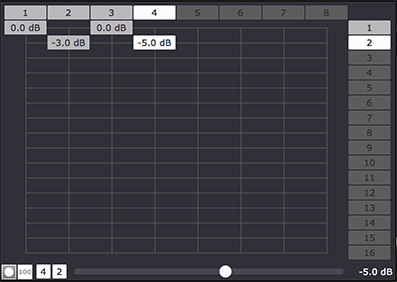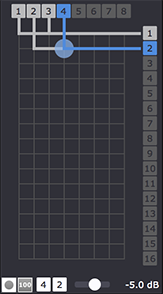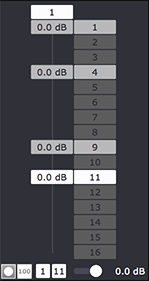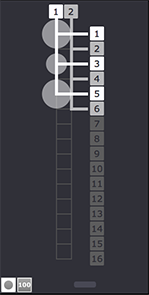Audio Features for Isadora: What Do You Want?
-
Dear All,
Here's the latest. I've adopted your suggestions regarding numeric values, but kept the possibility of the graphic view because I like it better.

You can also see that the volumes are displayed in dB. There will be a global setting for the file that allows you to switch all volumes to dB or to percentages, as you prefer.
Click here to watch the demo movie.
Numeric Version: 8 channel audio file to 16 channel output device with crosspoint 4-2 selected:

Graphic Version: 8 channel audio file to 16 channel output device with crosspoint 4-2 highlighted:

Numeric Version: Mono audio file to 16 channel output device with crosspoint 1-11 selected:

Numeric Version: Stereo audio file to 16 channel output device with crosspoint 2-6 selected:

Graphic Version: Stereo audio file to 16 channel output device with input channel 1 selected:

Best Wishes,
Mark -
really great. I also prefer the graphic version but it is good to have the possibility in some case to switch to the numeric version.
thanks for the fantastic work.
Jean-François
-
Sometimes all caps are appropriate: WONDERFUL!
John
-
@mark that is EXACTLY what I imagined. Bravo
-
Hi @mark,
That is looking good and feature rich. I just had a thought about presets. Will it be possible to save a routing configuration as a preset? For example, setting up a sound player/movie player with a specific routing and then saving in a user actor might be an option. Or the string configuration input in a user actor - perhaps there will be a number of ways to save user presets?
Best Wishes
Russell
-
If we get the output of the mapping (string with things like routing and volume) (can be hidden on default) we can easily feed this in an Data Array actor and use a Switch to grab the data and do different presets

-
@juriaan said:
output of the mapping (string with things like routing and volume)
Hi @Juriaan,
So that is a feature request then, to have an output string that provides the current properties of the multichannel setup?
I can’t recall if @mark provided, with the input string, a way to specify volume levels for each channel or if it is just the routing structure.
A text string input that includes channel volume and routing would suffice to allow user saved presets. But I agree an output that can be used to save current channel routing and volumes would be much better.
Best wishes
-
Exactly. If we can both input and output the exact configuration but then in a string so something like 1:13 75% 2:4 100% 7:9,10,11 50% feed that back in some data array / swith we can make some really powerfull user actors that I'm willing to provide and share on Plugins page

-
@juriaan said:
really powerfull user actors that I'm willing to provide and share on Plugins page
That’s so great!
We will have to lobby @mark to consider adding that functionality. I know the input string is part of the plan, but I don’t know if the output string is a big ask or not?
Best wishes
Russell
-
I do like the numeric setup. Gives you a quick overview of all settings. Great work Mark
-
We will have to lobby @mark to consider adding that functionality. I know the input string is part of the plan, but I don’t know if the output string is a big ask or not?
It's not a big ask because it's that's how it already works. The default format of the 'routing' input is a string in the following form:
s:d [@v]
where s is the source channel, d is the destination channel. if this is followed by an @ sign, then you can specify a volume from 0 to 100 followed by the '%' sign, or a volume reduction from 0db to -inf dB if the number is followed by 'db'.
You would have one of these for each source to destination routing, separated by commas. For example:
1:3@50%, 2:4@-3db
Would route source channel 1 to output 3 at 50% volume and source channel 2 to output 4 with a volume reduction -3db volume.
When you click on this input, it converts the string into the Matrix Router interface element shown previously. When you use this UI element to change the routing, it updates enters the updated string for you. The only issue I have to deal with is to offer some modifier key to allow you to edit the string directly if you want. Right now, there's no option to do that. When you click on the input, you always get the Matrix Router UI element.
I will take the preset idea under advisement, but that's a whole additional UI thing to manage. (You need a way to add one, delete one, change the name, etc.)
Anway, the string functionality is there already. Happy?

Best Wishes,
Mark -
@mark said:
Happy?
Elated!
So what you are saying is that a ‘new’ feature output that provided current channel mapping and volume is possible for the Sound Player? And/or the input might be modified to allow reconfiguring/saving the string directly, bypassing the UI pop out.
A string output could then be used to match and modify audio matrix settings of other Sound Players/Movie Players in subsequent scenes. Or saved and transferred to other patch files.
That would be very useful, I think.
Best wishes
Russell
-
@bonemap said:
So what you are saying is that a ‘new’ feature output that provided current channel mapping and volume is possible for the Sound Player? And/or the input might be modified to allow reconfiguring/saving the string directly, bypassing the UI pop out.
It also means that you can interactively change the routing between presets

-
-
@fred said:
andom question. what happens if there are movie players with different routings in scenes that crossfade? I'm guessing you solved this already, will it fade in and out on all channels?
Well, the first movie would fade out and the second would fade up.
Let's say you have a stereo movie in both scenes. In Scene 1, the two channels are routed to outputs 7 and 8. In Scene 2, the two channels are routed to 6 and 7. As the volume of Scene 1 goes down during the cross fade, the first movie's audio on 7 and 8 fades out. Simultaneously, as the volume of Scene 2 goes up during the cross fade, the second movie's audio on 6 and 7 fades in.
Best Wishes,
Mark -
@bonemap said:
So what you are saying is that a ‘new’ feature output that provided current channel mapping and volume is possible for the Sound Player?
Not sure what you're saying here... "feature output" ??? The new 'routing' input is an input, not an output. I don't think I said anything about outputs.
But I'll just go over it again: the routing input for the Sound Player (working now) and the Movie Player (will come during phase II of this project) is a text string. You can feed that text from anywhere you'd can provide text: a Trigger Text actor, a Text Formatter actor, a Get Global Values actor, etc.
That said, I can see a new actor that implements the routing UI element when you click it, and provide the routing string as an output. Maybe that's what you mean?
Best Wishes,
Mark -
@mark yes, as expected, I don't know why I would have thought otherwise
-
What we are proposing is that we get the routing that is inside the Sound Player (Movie player in phase 2) as an output of the Sound Player that contains a string value with the routing. So just like the input string that we provide we would love to get the same on the output side of the actor
That way we can use that string again to make some powerfull user actors (like a preset system)
-
@juriaan said:
What we are proposing is that we get the routing that is inside the Sound Player (Movie player in phase 2) as an output of the Sound Player that contains a string value with the routing. So just like the input string that we provide we would love to get the same on the output side of the actorThat way we can use that string again to make some powerfull user actors (like a preset system)
Ooo I like this. That sounds tasty!

-
@mark said:
That said, I can see a new actor that implements the routing UI element when you click it, and provide the routing string as an output. Maybe that's what you mean?
Hi @mark,
Yes! That’s right an output string from the audio matrix UI. You are the consummate programmer so I know from participating and listening to many discussions like this over the years that you will see the most efficient, flexible and appropriate way to implement something in Isadora. And your vision for a new actor that outputs the matrix string appears to be the sensible way to resolve the potential of working with the audio settings over multiple scenes/ patches etc.
Best wishes
Russell